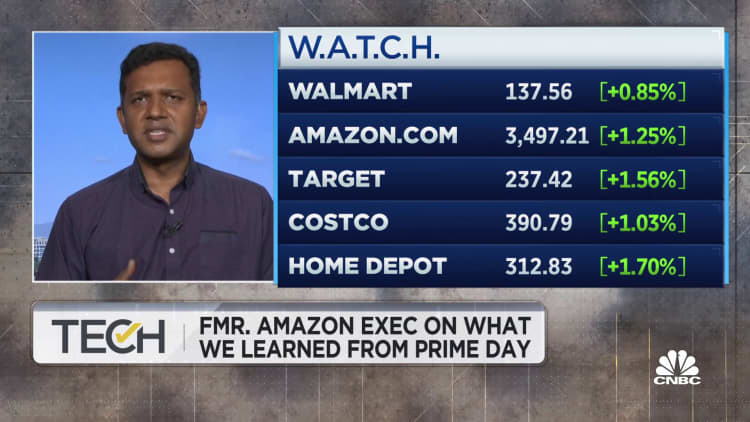This year's Amazon Prime Day drew in a flurry of deal-seeking shoppers who purchased more than 250 million items worldwide, ranging from robotic vacuums to Crest Whitestrips.
But that may not have been enough to catapult the 48-hour event, which wrapped up on Tuesday, to deliver stunning sales growth, as it has in previous years, Bank of America analysts said Thursday.
The bank highlighted a few "signs of soft growth" vs. 2020, including that Prime Day took place just 8 months after last year's event, versus 15 months between Prime Day 2019 and 2020. After last year's pandemic-delayed Prime Day in October — just before the Christmas holidays — the company brought the event back to its normal summertime slot.
Amazon disclosed few details about the results in its post-Prime Day rundown, Bank of America analysts said. The results noticeably lacked the typical sales superlatives often used by Amazon, as well as key figures like from third-party seller sales.
"Amazon did disclose that 250 million items were sold, which represents a 20% two-year [compound annual growth rate] from 175 million items sold in Prime Day 2019, but likely limited growth vs. 2020," Bank of America analysts Justin Post and Michael McGovern wrote in a note to investors. "Given the shorter period of time since the last Prime Day, the lack of new countries added, and the lack of new disclosures, we believe this was a relatively lower growth Prime Day vs. prior years."
Amazon doesn't disclose total Prime Day sales, but Post and McGovern estimate that Prime Day 2021 gross merchandise volume came in at $9.55 billion, up just 7% from last year. By comparison, they estimate 2020 Prime Day gross merchandise volume grew 54% year over year. In a report Wednesday, Adobe Analytics estimated that total U.S. e-commerce sales, including by Amazon competitors, were $11 billion during the two-day event.
Not everyone on Wall Street agreed that Prime Day was underwhelming, however.
In a separate note Thursday, Piper Sandler analysts said Prime Day results were likely in line with their estimates, forecasting Amazon brought in $7.5 billion during the two-day event. That's "a solid result, especially notable given Canada and India did not participate due to Covid," Piper Sandler analysts Thomas Champion and James Callahan wrote.
Baird analysts on Wednesday pointed to Salesforce data indicating that Prime Day and other competing deals slumped 1% compared with last year's events in October. While the data may be viewed as disappointing, the company's analysts said they weren't too alarmed.
"It's essentially in line with our forecast for 'slightly lower sales,'" the analysts wrote. "Our assumption was based largely on the limited physical store openings last fall, as well as the proximity of October Prime Days to the holiday shopping season."



